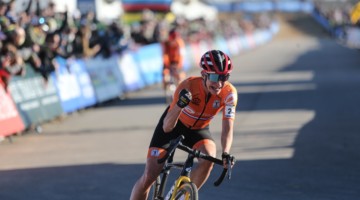Cyclocross fans were shocked by the news of Katie Compton’s four-year USADA ban for anti-doping violations. Reports of different tests, isotopes, ratios, biological passports and terms like anabolic androgenic steroids had most of us turning to Google, or turning away in confusion.
Bruce Hildenbrand has covered professional cycling for four decades, and in that timeframe, he has developed more than a layman’s knowledge of the unfortunate, darker side of the sport. He offers Cyclocross Magazine readers his insight and some background on the recent events that surround Compton’s positive test and subsequent four-year USADA ban.
The stunning news that Katie Compton received a four-year doping ban for an anabolic androgenic steroid raised more questions than answers. Given that the Carbon Isotope Ratio (CIR) test was used to re-analyze her urine sample, it likely indicates that the ‘anabolic androgenic steroid’ was testosterone.
Katie Compton’s husband, Mark Legg-Compton, has since confirmed the substance was exogenous testosterone in a Facebook post.
It is well known that testosterone aids in recovery. Top professional road riders including Floyd Landis and Tom Danielson have been busted for testosterone by the CIR test, but it is not used very frequently by anti-doping laboratories.
This new finding brings the whole problem of the current form of testosterone testing to the forefront. For years, the testosterone-to-epitestosterone ratio test, known a the T/E Ratio test, has been used to determine if an athlete is taking an external source of testosterone.
Unfortunately, if an athlete is using a water-soluble version of testosterone and they take it during the late evening/early morning windows when athletes are not typically tested, it is very easy to beat the T/E Ratio test. This is the reason why the CIR test was developed. Using a gas chromatograph and mass spectrometer, the test can accurately detect the different carbon isotopes which occur between naturally occurring testosterone, which the human body produces in the gonads for men and ovaries for women, and the plant-based testosterone which is the form taken externally.
Why continue to use a flawed test? The reason why the T/E Ratio test is still being endorsed and used by the World Anti-Doping Agency (WADA) accredited anti-doping labs is that it costs about $30 per test whereas the CIR test costs about $300 per test.
In the sport of cycling, in-competition dope testing is typically paid for by the race, whereas the anti-doping agencies, such as USADA, pay for out-of-competition testing. Unfortunately, it just comes down to a matter of economics and not which test is the most accurate. However, as we’ve seen with samples from the last few Olympic Games, athlete’s samples, which are stored just for this purpose, are being re-tested. This can happen when new tests are developed, or in the case here with Katie Compton, when her biological passport indicated that her sample might need additional testing, USADA can use the more accurate CIR test.
So, what does this mean for Katie Compton? Recent changes to the WADA code require a four-year ban for the first doping offense. Clearly, the anti-doping authorities believe the results of their tests. The only avenue for Katie is to either challenge the handling of her sample or how her tests were performed, or perhaps prove it was unintentional and get a reduced sentence. Such a challenge is expensive and can cost hundreds of thousands of dollars. Some athletes in the early stages of their careers have chosen just to sit out the ban. Being near the end of her career, Katie chose to retire.
Bruce Hildenbrand has been covering the sport of professional cycling in the US and Europe for over 40 years. He has reported on numerous doping cases for major media outlets such as Outside Magazine.

What will fans focus on in remembering Compton’s career given the recent news? photo: 2018 Superprestige Gavere Women. © A. Yee / Cyclocross Magazine




























